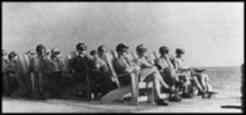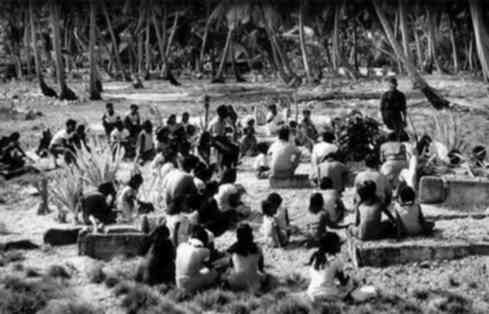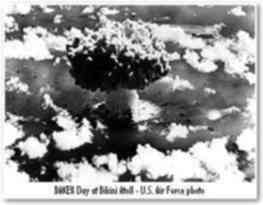Bikini Atoll is one of the 29 atolls and five islands that compose the Marshall Islands. These atolls of the Marshalls are scattered over 357,000 square miles of a lonely part of the world located north of the equator in the Pacific Ocean. They help define a geographic area referred to as Micronesia. Once the Marshalls were discovered by the outside world, first by the Spanish in the 1600's and then later by the Germans, they were used primarily as a source for producing copra oil from coconuts. The Bikini islanders maintained no substantial contacts with these early visitors because of Bikini Atoll's remote location in the very dry, northern Marshalls. The fertile atolls in the southern Marshalls were attractive to the traders because they could produce a much larger quantity of copra. This isolation created for the Bikinians a tightly integrated society bound together by close extended family association and tradition, where the amount of land you owned was a measure of your wealth.
In the early 1900's the Japanese began to administer the Marshall Islands. This domination later resulted in a military build up throughout the islands in anticipation of World War II. Bikini and the rest of these peaceful,  low lying coral atolls in the Marshalls suddenly became strategic. The Bikini islanders' life of harmony drew to an abrupt close when the Japanese decided to build and maintain a watchtower on their island to guard against an American invasion of the Marshalls. Throughout the conflict the Bikini station served as an outpost for the Japanese military headquarters in the Marshall Islands, Kwajalein Atoll.
low lying coral atolls in the Marshalls suddenly became strategic. The Bikini islanders' life of harmony drew to an abrupt close when the Japanese decided to build and maintain a watchtower on their island to guard against an American invasion of the Marshalls. Throughout the conflict the Bikini station served as an outpost for the Japanese military headquarters in the Marshall Islands, Kwajalein Atoll.
 low lying coral atolls in the Marshalls suddenly became strategic. The Bikini islanders' life of harmony drew to an abrupt close when the Japanese decided to build and maintain a watchtower on their island to guard against an American invasion of the Marshalls. Throughout the conflict the Bikini station served as an outpost for the Japanese military headquarters in the Marshall Islands, Kwajalein Atoll.
low lying coral atolls in the Marshalls suddenly became strategic. The Bikini islanders' life of harmony drew to an abrupt close when the Japanese decided to build and maintain a watchtower on their island to guard against an American invasion of the Marshalls. Throughout the conflict the Bikini station served as an outpost for the Japanese military headquarters in the Marshall Islands, Kwajalein Atoll.After the war, in December of 1945, President Harry S. Truman issued a directive to Army and Navy officials that joint testing of nuclear weapons would be necessary "to determine the effect of atomic bombs on American warships." Bikini, because of its location away from regular air and sea routes, was chosen to be the new nuclear proving ground for the United States government.
In February of 1946 Commodore Ben H. Wyatt, the military governor of the Marshalls, traveled to Bikini. On a Sunday after church, he assembled the Bikinians to ask if they would be willing to leave their atoll temporarily so that the United States could begin testing atomic bombs for "the good of mankind and to end all world wars." King Juda, then the leader of the Bikinian people, stood up after much confused and sorrowful deliberation among his people, and announced, "We will go believing that everything is in the hands of God."
 While the 167 Bikinians were getting ready for their exodus, preparations for the U.S. nuclear testing program advanced rapidly. Some 242 naval ships, 156 aircraft, 25,000 radiation recording devices and the Navy's 5,400 experimental rats, goats and pigs soon began to arrive for the tests. Over 42,000 U.S. military and civilian personnel were involved in the testing program at Bikini.
While the 167 Bikinians were getting ready for their exodus, preparations for the U.S. nuclear testing program advanced rapidly. Some 242 naval ships, 156 aircraft, 25,000 radiation recording devices and the Navy's 5,400 experimental rats, goats and pigs soon began to arrive for the tests. Over 42,000 U.S. military and civilian personnel were involved in the testing program at Bikini. The nuclear legacy of the Bikinians began in March of 1946 when they were first removed from their islands in preparation for Operation Crossroads. The history of the Bikinian people from that day has been a story of their struggle to understand scientific concepts as they relate to their islands, as well as the day-to-day problems of finding food, raising families and maintaining their culture amidst the progression of events set in motion by the Cold War that have been for the most part out of their control.
 In preparation for Operation Crossroads, the Bikinians were sent 125 miles eastward across the ocean on a U.S. Navy LST landing craft to Rongerik Atoll. The islands of Rongerik Atoll were uninhabited because, traditionally, the Marshallese people considered them to be unlivable due to their size (Rongerik is 1/6 the size of Bikini Atoll) and because they had an inadequate water and food supply. There was also a deep-rooted traditional belief that the atoll was inhabited by evil spirits. The Administration left the Bikinians food stores sufficient only for several weeks. The islanders soon discovered that the coconut trees and other local food crops produced very few fruits when compared to the yield of the trees on Bikini. As the food supply on Rongerik quickly ran out, the Bikinians began to suffer from starvation and fish poisoning due to the lack of edible fish in the lagoon. Within two months after their arrival they began to beg U.S. officials to move them back to Bikini.
In preparation for Operation Crossroads, the Bikinians were sent 125 miles eastward across the ocean on a U.S. Navy LST landing craft to Rongerik Atoll. The islands of Rongerik Atoll were uninhabited because, traditionally, the Marshallese people considered them to be unlivable due to their size (Rongerik is 1/6 the size of Bikini Atoll) and because they had an inadequate water and food supply. There was also a deep-rooted traditional belief that the atoll was inhabited by evil spirits. The Administration left the Bikinians food stores sufficient only for several weeks. The islanders soon discovered that the coconut trees and other local food crops produced very few fruits when compared to the yield of the trees on Bikini. As the food supply on Rongerik quickly ran out, the Bikinians began to suffer from starvation and fish poisoning due to the lack of edible fish in the lagoon. Within two months after their arrival they began to beg U.S. officials to move them back to Bikini.
The two atomic bomb blasts of Operation Crossroads were both about the size of the nuclear bomb dropped on Nagasaki, Japan. Eighteen tons of cinematography equipment and more than half of the world's supply of motion picture film were on hand to record the Able and Baker detonations, and also the movement of the Bikinians from their atoll.
From December of 1946 through January of 1947, the food shortages worsened on Rongerik; the small population of Bikinians was confronted with near starvation. During the same period of time, the area of Micronesia was designated as a United Nations Strategic Trust Territory (TT) to be administered by the United States. Indeed, it was the only strategic trust ever created by the United Nations. In this agreement, the U.S. committed itself to the United Nations directive to "promote the economic advancement and self-sufficiency of the inhabitants, and to this end shall...protect the inhabitants against the loss of their lands and resources
..." The people of Bikini have long seen the irony in the conduct of the TT agreement that allowed the bombing of their homeland and that forced them into starvation on Rongerik Atoll.
For more details please click HERE
3 comments:
The one fact that really bothers me is that, how could it that America did a nuclear test on such a powerful nuclear weapon on an island that is actually home for some people. They might have evacuated the native people but they eventually came back and lived in a place that has been contaminated. it's just sad.
That's true!
i was thinking the same way. I don't really know what are they thinking at that time doing those bomb testing. It was clearly shown in the film Daigo Fukuryu Maru, that the fishermen refuse help from America because they don't even said any apologize.
Well,, but in fact, there is no significant movement from the victim as a protest.
I guess America is too strong for them.
Post a Comment